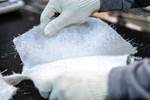High-velocity fan technology for fiberglass dust cleanup
CAMX 2024: SonicAire presents dust-control fans to simplify dust cleanup in fiberglass facilities using its high-velocity BarrierAire technology.

Source | SonicAire
SonicAire (Winston-Salem, N.C., U.S.) is presenting NFPA-compliant solutions in the form of its proprietary BarrierAire fan technology, engineered to automate overhead housekeeping, control combustible dust buildup and eliminate the need for manual dust cleanup in fiberglass facilities.
The dust control fans are specifically designed to prevent dust from settling in hard-to-reach areas. Their high-velocity airflow prevent combustible fiberglass dust particles from settling on overhead structures, which can improve facility safety. In addition, thermal current control helps prevent dust buildup in inaccessible areas prone to fire and explosion risks.
Fully automated, SonicAire fugitive dust management simplifies the task of maintaining cleanliness and safety in fiberglass facilities. This not also eliminates the need to schedule weekend work, extend business hours or halt production for cleaning purposes.
Various SonicAire fan options are available, including:
- Pro Series: For typical fiberglass environments.
- Extreme Series: For harsh fiberglass manufacturing environments, including the only dust control fan certified for Class II, Div. 1 hazardous locations.
- Specialty Series: For custom fiberglass applications.
- Command Series: Customizable fan control systems for optimal operation in each fiberglass setting.
In addition, SonicAire provides complimentary dust management plans and ROI analysis. Its engineering team will create a tailored analysis demonstrating how SonicAire fans can minimize combustible dust buildup, enhance worker safety and productivity, and provide compliance with OSHA regulations. The team will also deliver an ROI analysis outlining long-term cost savings.
Related Content
-
Natural fiber composites: Growing to fit sustainability needs
Led by global and industry-wide sustainability goals, commercial interest in flax and hemp fiber-reinforced composites grows into higher-performance, higher-volume applications.
-
Infinite Composites: Type V tanks for space, hydrogen, automotive and more
After a decade of proving its linerless, weight-saving composite tanks with NASA and more than 30 aerospace companies, this CryoSphere pioneer is scaling for growth in commercial space and sustainable transportation on Earth.
-
Manufacturing the MFFD thermoplastic composite fuselage
Demonstrator’s upper, lower shells and assembly prove materials and new processes for lighter, cheaper and more sustainable high-rate future aircraft.














.jpg;maxWidth=300;quality=90)
